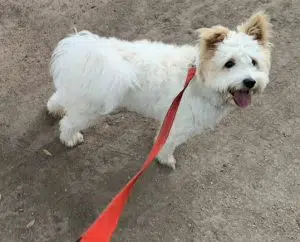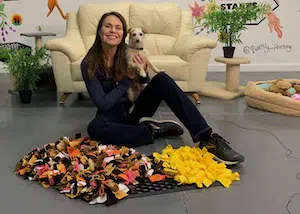
Independence training is important at all stages of a dog’s life to help build their confidence and comfort in being left alone. As people start to return to work in the new year, this is more important than ever.
As a dog behaviourist, I am seeing many owners that are having problems with their puppies and even older dogs due to anxiety and a lack of proper socialisation during lockdown.
Unfortunately, many puppies missed out on puppy school and the wider socialisation they need during the critical period of development, while many adopted pets have only known life with their new family working or schooling from home so independence training can help with a smooth transition.
Even for dogs that have not shown any pre-existing signs of anxiety, being at home with the family every day to suddenly only mornings and nights is likely to take an emotional toll on any pet, which is why starting independence training now is a must, as separation anxiety is a big problem that many dog owners face and can be hard to overcome if it is not addressed in the early stages.
Signs of anxiety in pets include trembling, licking of lips, pacing, increased drooling or salivation, shaking or a decrease in appetite, vomiting and diarrhoea, so look out for these and also behaviours like chewing, digging, excessive barking and other destructive behaviours.
When doing independence training it helps to ensure your dog has their own special place where they feel safe and secure, where only good things happen.
Ideally they will have a spot both outside in the yard such as a sturdy, secure and comfortable kennel or shed, where they are protected from the elements and that they enjoy spending time in, as well as access to a place to call their own inside the home with their bed and favourite toys.
Crate training your dog is great for indoors and travel and, if done properly, your dog is likely to take themselves to their crate regularly when they want some time out from the kids or a noisy household, to sleep or if they are feeling a bit anxious.
Even if you are at home all day, create frequent separations from your dog. For most dogs, 3-5 times alone per day can be enough to help keep separation anxiety at bay.
Use positive reinforcement behaviour training to put it on cue such as “Go to your crate,” or “Go to your place” and send them there with a treat, toy or long lasting chew. Learn how to do place training HERE.
It is also good to have your dog spend time out in the yard by themselves. Providing them with an interactive toy or safe bone can help keep them occupied.
It is important not to just think that your dog will ‘get used to it’, as separation anxiety can be extremely distressing for a dog. A great exercise to do with your dog is to start by leaving them with a long lasting chew and just going for a walk around the block, returning while they are still occupied and haven’t had time to start getting anxious yet.
Watch and read about how to do this properly HERE.
To prepare your dog for your return to work, start getting into a more sustainable walking routine, ideally first thing in the morning and again at the end of the work day if you aren’t already
Of course it is vital that your dog’s exercise continues in the same way when you return to work as dogs need to get out and explore the world around them – it is very important for their mental wellbeing!
Note if you have a rescue dog that is extremely fearful or reactive however, you should seek the services of a vet behaviourist or dog trainer to determine the best approach, as in some cases exposing them to too many things they are fearful of may make it worse.
In general though, routine walks and meeting a dog’s individual exercise needs not only helps with anxiety and boredom, it will help keep your fitness levels up as well. A tired dog gets into less physical and mental mischief when left alone!
If you can’t maintain the exercise they need for their age, breed and size, then consider hiring a dog walker.
Nose work and scenting games that tap into your dog’s natural hunting instincts are a great way to help keep both boredom and anxiety at bay.
Try hiding your dog’s treats or kibble around the yard or lounge as a game of treat treasure hunt, so they can spend some time on their own foraging for their food, which is a great tool for some independence training.
If you put this on cue such as ‘find your treats’ you can also use that when you are departing the house to help create a positive association with your departure.
Enrichment toys such as Kongs, Aussie Dog Home Alone, or food puzzles help to provide pets with the extra mental and physical stimulation and exercise that so many dogs desperately need. Make sure you rotate their toys regularly too to keep it interesting.
For many working dog breeds such as Border Collies and Kelpies, it also helps give them a job to do which is what they need.
Dogs are watching our every move, so can work themselves up into a state before you have even left the house if you always have the same routine when you head off to work.
There’s a couple of ways to do this which includes changing the order of your departure routine constantly, as well as normalising some of your departure sounds and movements by rattling your keys and grabbing your bag, but not actually leaving the house so they are not associated with you leaving every time.
Watch my You Tube video on this HERE.
Keep your arrivals and departures calm. After every separation, walk inside and ignore any excited jumping, barking or other attention seeking behaviour.
Any moment they have a break in the barking or have all four feet on the ground (if jumping is their thing), then you can greet them as warmly and playfully as you like. Likewise, leave your dog without any elaborate goodbye ritual.
It is important to also start by leaving them for short periods of time. Check out my You Tube video on how to build up your dog’s time alone positivley.
If you have a puppy, encourage independence straight away by not responding to every whimper and giving them what they want.
If we won’t allow them to feel the discomfort and continuously provide them with the opportunity to practice it, then they won’t learn the lesson of how to self soothe and trust that you’ll be back in your own time. Instead, they will learn that they can avoid their discomfort by whimpering and calling you to come back. It is important however that you are providing the with interactive toys or long lasting chews, so they are kept occupied as well and aren’t acting out due to boredom, or leaving them for long periods.
With all dogs, set some boundaries regarding access to you and places around the home and be consistent. A lack of clear and consistent boundaries around the home, and the same rules with all family members, is often where dogs get confused and being a good leader suffers.
Obedience train your dog to only jump up on the couch, come into the kitchen, be on the bed etc. when you invite them to. Use positive reinforcement training to help your puppy understand the desired behaviour you want from them, and make sure you aren’t actually rewarding them for the behaviour you don’t want.
It is also important that we do not reinforce our dog’s anxiety. I see this all the time. To find out how owners tend to make their dog’s anxiety worse without realising it, click here.
Likewise do not reinforce attention seeking behaviour ie: jumping up, barking or whining at you. Ignore it, do not look or touch them. Wait until they are quiet, then reward to reinforce that desired behaviour. Attention comes on your terms not theirs! Find out more about that here.
For some dogs their anxiety can be likened to a panic attack like we humans may experience, causing them to engage in destructive and self-harming behaviours. It’s important to understand that dogs with true separation anxiety aren’t “acting out” because their owners are away — they’re feeling overwhelming panic they have no control over.
I’ve had many a client say their dog starting peeing in the house on purpose, to get back at them or they looked guilty when they got home so ‘knew’ they did wrong. None of this is true.
Dog’s have cognitive ability of a two to two and a half year old child, so while they feel basic human emotions like happiness, sadness, loneliness, excitement and joy, they don’t have the ability to feel guilt or malice – this is backed up by science.
Latent punishment (ie: punishing your dog for an action more than 5 seconds after it has occurred) or punishing them for a behaviour that is occurring because they are scared, will only create more fear and anxiety and make problem behaviours worse.
If your dog suffers from anything more than mild separation anxiety and independence training is not helping, or it gets worse, then you must seek the advice of a vet, ideally a vet behaviourist or experienced dog trainer to help provide some solutions, which may include natural or other medications.
There are also a range of calming products such as Adaptil and Feliway, along with Thundershirts and even Dog TV that can assist anxious dogs, so visit our friends at PETstock to learn more about these and other products and interactive toys.
About the Author: Lara Shannon is a certified dog behaviourist and trainer, Executive Producer and Host of Pooches at Play on Channel 10 and editor of Poochesatplay.com. Lara runs her own dog training business in Melbourne’s Bayside area, is a sought after pet expert speaker and Author of Eat, Play, Love (Your Dog) and World of Dogs.


Walking a dog – how much and why

Tips for exercising a dog indoors

The benefits of Snuffle Mats for dogs

Exercising puppies – how much do they need?


Get your paws on Lara Shannon’s best selling books ‘Eat, Play, Love (your dog) and World of Dogs.
Available in Australia, USA, UK and Canada.